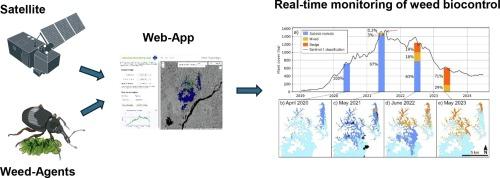Optimizing aquatic weed management in Lake Ossa, Cameroon: Harnessing the power of biological control and real-time satellite monitoring
IF 3.7
2区 农林科学
Q2 BIOTECHNOLOGY & APPLIED MICROBIOLOGY
引用次数: 0
Abstract
Salvinia, Salvinia molesta Mitchell (Salviniaceae) is a free-floating aquatic fern native to Brazil and considered one of the worst weeds in the world. When left unchecked, salvinia forms dense mats on the water surface, limiting sunlight penetration and altering water quality that disrupt ecosystem processes. In 2016, salvinia was first reported in Lake Ossa, Cameroon, and by summer 2021, had expanded to cover almost 49 % of the lake’s 4,000-hectare surface. A multinational team initiated a biological control and monitoring program, importing the salvinia weevil, Cyrtobagous salviniae Calder & Sands (Coleoptera: Curculionidae) from Louisiana, USA, in summer 2021. The objectives of this study were to: quantify the changes in salvinia cover and other floating vegetation, document the establishment and impact of the biological control program, and deliver a tool for near-real time monitoring of floating vegetation. We developed a satellite-based remote sensing application to document in near real-time the changes in coverage of floating vegetation. Using this tool, we quantified the reduction in the salvinia coverage by 80 % within three years of the release of the weevil. Field surveys in 2022 and 2023, demonstrated weevil establishment in the lake and widespread salvinia browning that was associated with weevil damage. Linear regressions of the percent cover of floating vegetation over time, demonstrated that after the weevil release, the rate of change decreased to −1.7 % per 60 days. Field monitoring and satellite imagery showed the establishment of a sedge (Oxycaryum sp., Cyperaceae) within the salvinia mat in late 2021. This secondary invasion slowed the reduction in coverage of floating vegetation from −1.7 % to −0.6 % per 60 days, and warrants further research. By late 2023, the revitalization of Lake Ossa restored fishing and transportation opportunities for the community, and also the comeback the emblematic African manatee. The success of the biological control of salvinia in Lake Ossa is not surprising due to its tropical conditions. However, it highlights the importance of early intervention and continuous monitoring. We propose that the integration of biological control and remote sensing technology is becoming more accessible and can be automated; therefore, a replicable model for future invasive weed programs around the world.

优化喀麦隆奥萨湖的水生杂草管理:利用生物控制和实时卫星监测的力量
沙参(Salvinia molesta Mitchell,沙参科)是一种原产于巴西的自由漂浮的水生蕨类植物,被认为是世界上最严重的杂草之一。如果任其发展,沙维氏蕨会在水面上形成密集的毡垫,限制阳光的穿透,改变水质,破坏生态系统进程。2016 年,喀麦隆奥萨湖首次出现了沙维氏藻,到 2021 年夏季,沙维氏藻的面积已扩大到该湖 4000 公顷湖面的近 49%。2021 年夏季,一个多国团队从美国路易斯安那州引进了沙维氏象鼻虫,Cyrtobagous salviniae Calder & Sands(鞘翅目:钩虫科),启动了一项生物控制和监测计划。这项研究的目标是:量化沙维氏藻覆盖面和其他漂浮植被的变化,记录生物防治计划的建立和影响,并提供一种近实时监测漂浮植被的工具。我们开发了一种基于卫星的遥感应用,用于近实时记录漂浮植被覆盖率的变化。利用这一工具,我们量化了在释放象鼻虫后的三年内,沙维氏藻的覆盖率减少了 80%。2022 年和 2023 年的实地调查表明,象鼻虫已在湖中生根发芽,大面积的沙维藻褐变与象鼻虫的破坏有关。浮游植被覆盖率随时间变化的线性回归结果表明,象鼻虫释放后,浮游植被覆盖率的变化率降至每 60 天-1.7%。实地监测和卫星图像显示,2021 年下半年,沙棘席内出现了一种莎草(Oxycaryum sp.这种二次入侵减缓了漂浮植被覆盖率的下降速度,从每 60 天-1.7%降至-0.6%,值得进一步研究。到 2023 年底,奥萨湖恢复了生机,为社区恢复了捕鱼和运输机会,标志性的非洲海牛也卷土重来。由于奥萨湖地处热带,生物防治沙维氏藻的成功并不令人惊讶。不过,这也凸显了早期干预和持续监测的重要性。我们认为,生物防治与遥感技术的结合正变得越来越容易获得,而且可以实现自动化;因此,这是未来世界各地入侵杂草计划的一个可复制模式。
本文章由计算机程序翻译,如有差异,请以英文原文为准。
求助全文
约1分钟内获得全文
求助全文
来源期刊

Biological Control
生物-昆虫学
CiteScore
7.40
自引率
7.10%
发文量
220
审稿时长
63 days
期刊介绍:
Biological control is an environmentally sound and effective means of reducing or mitigating pests and pest effects through the use of natural enemies. The aim of Biological Control is to promote this science and technology through publication of original research articles and reviews of research and theory. The journal devotes a section to reports on biotechnologies dealing with the elucidation and use of genes or gene products for the enhancement of biological control agents.
The journal encompasses biological control of viral, microbial, nematode, insect, mite, weed, and vertebrate pests in agriculture, aquatic, forest, natural resource, stored product, and urban environments. Biological control of arthropod pests of human and domestic animals is also included. Ecological, molecular, and biotechnological approaches to the understanding of biological control are welcome.
 求助内容:
求助内容: 应助结果提醒方式:
应助结果提醒方式:


